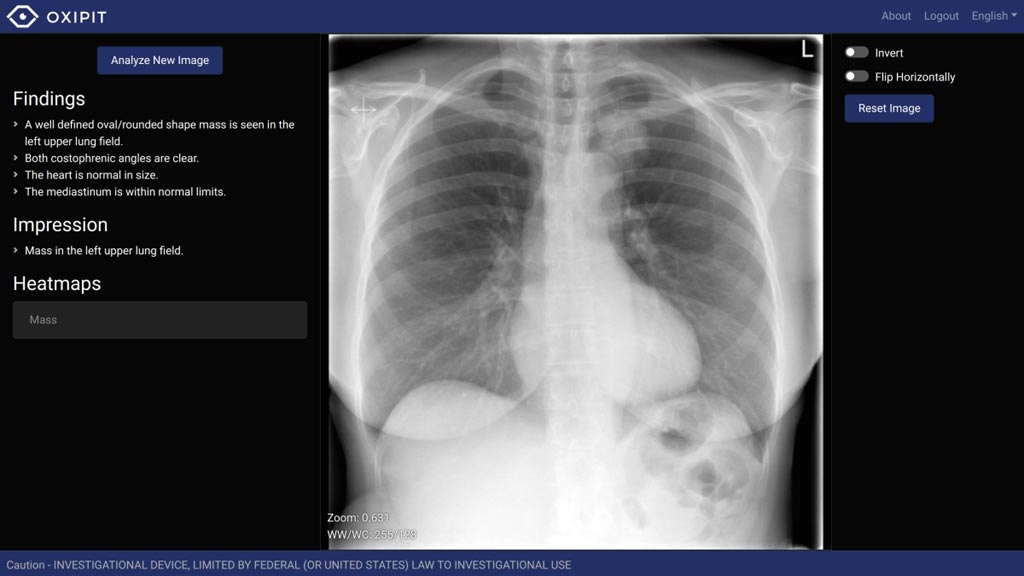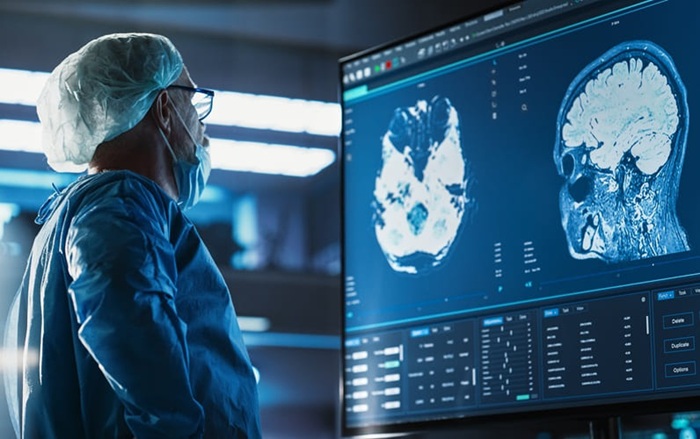AI-based Software for Chest X-rays Receives CE Certification
|
By MedImaging International staff writers Posted on 20 Feb 2019 |

Image: A screenshot from the ChestEye radiology imaging suite (Photo courtesy of Oxipit).
Oxipit (Vilnius, Lithuania), a provider of AI-based medical imaging solutions, has received CE certification for its ChestEye radiology imaging suite. Oxipit ChestEye provides analysis and preliminary reports for 75 most common radiological findings - the largest scope of diagnosis currently available on the market - with an average area under curve metric of 93%.
ChestEye imaging suite encompasses a fully automatic computer aided diagnosis (CAD) platform which supports 75 radiological findings. The software localizes these features on a radiograph as a heatmap. It also generates a standardized preliminary text report that incorporates all the radiologically relevant information present in a chest X-ray image. Its search module incorporates a search engine for finding similar-looking chest X-rays in a given database, empowering the user to quickly find retrospective cases with a similar radiological appearance. The similarity is identified by a neural network, which judges on the pathology present as well as the location of the pathology, its severity and other features.
The suite also includes a patient prioritization solution. After receiving the input of ChestEye scan results, the platform prioritizes potentially unhealthy patients inviting urgent specialist attention. By automatically arranging scans on the basis of urgency, it reduces time-to-treatment for time sensitive conditions such as pericardial effusion, pneumothorax, catheter or intubation malposition. The ChestEye suite is available for deployment on premises as well as a cloud-based software and seamlessly integrates into the workflow of any radiology department.
ChestEye is the first AI-based full workflow medical imaging suite to be certified by a CE mark which ensures that the software complies with medical device regulations and paves the way for commercial deployments in 32 European countries.
“The burden on radiologists has been constantly increasing. This has led to decline in quality of service for patients and bottlenecks to access good quality radiological reporting. The CE mark brings us a step closer in helping radiologists to harness the capabilities of Deep Learning in order to multiply their productivity and provide excellent service around the clock,” said Oxipit CEO Gediminas Peksys.
Related Links:
Oxipit
ChestEye imaging suite encompasses a fully automatic computer aided diagnosis (CAD) platform which supports 75 radiological findings. The software localizes these features on a radiograph as a heatmap. It also generates a standardized preliminary text report that incorporates all the radiologically relevant information present in a chest X-ray image. Its search module incorporates a search engine for finding similar-looking chest X-rays in a given database, empowering the user to quickly find retrospective cases with a similar radiological appearance. The similarity is identified by a neural network, which judges on the pathology present as well as the location of the pathology, its severity and other features.
The suite also includes a patient prioritization solution. After receiving the input of ChestEye scan results, the platform prioritizes potentially unhealthy patients inviting urgent specialist attention. By automatically arranging scans on the basis of urgency, it reduces time-to-treatment for time sensitive conditions such as pericardial effusion, pneumothorax, catheter or intubation malposition. The ChestEye suite is available for deployment on premises as well as a cloud-based software and seamlessly integrates into the workflow of any radiology department.
ChestEye is the first AI-based full workflow medical imaging suite to be certified by a CE mark which ensures that the software complies with medical device regulations and paves the way for commercial deployments in 32 European countries.
“The burden on radiologists has been constantly increasing. This has led to decline in quality of service for patients and bottlenecks to access good quality radiological reporting. The CE mark brings us a step closer in helping radiologists to harness the capabilities of Deep Learning in order to multiply their productivity and provide excellent service around the clock,” said Oxipit CEO Gediminas Peksys.
Related Links:
Oxipit
Latest Industry News News
- GE HealthCare and NVIDIA Collaboration to Reimagine Diagnostic Imaging
- Patient-Specific 3D-Printed Phantoms Transform CT Imaging
- Siemens and Sectra Collaborate on Enhancing Radiology Workflows
- Bracco Diagnostics and ColoWatch Partner to Expand Availability CRC Screening Tests Using Virtual Colonoscopy
- Mindray Partners with TeleRay to Streamline Ultrasound Delivery
- Philips and Medtronic Partner on Stroke Care
- Siemens and Medtronic Enter into Global Partnership for Advancing Spine Care Imaging Technologies
- RSNA 2024 Technical Exhibits to Showcase Latest Advances in Radiology
- Bracco Collaborates with Arrayus on Microbubble-Assisted Focused Ultrasound Therapy for Pancreatic Cancer
- Innovative Collaboration to Enhance Ischemic Stroke Detection and Elevate Standards in Diagnostic Imaging
- RSNA 2024 Registration Opens
- Microsoft collaborates with Leading Academic Medical Systems to Advance AI in Medical Imaging
- GE HealthCare Acquires Intelligent Ultrasound Group’s Clinical Artificial Intelligence Business
- Bayer and Rad AI Collaborate on Expanding Use of Cutting Edge AI Radiology Operational Solutions
- Polish Med-Tech Company BrainScan to Expand Extensively into Foreign Markets
- Hologic Acquires UK-Based Breast Surgical Guidance Company Endomagnetics Ltd.
Channels
Radiography
view channel
X-Ray Breakthrough Captures Three Image-Contrast Types in Single Shot
Detecting early-stage cancer or subtle changes deep inside tissues has long challenged conventional X-ray systems, which rely only on how structures absorb radiation. This limitation keeps many microstructural... Read more
AI Generates Future Knee X-Rays to Predict Osteoarthritis Progression Risk
Osteoarthritis, a degenerative joint disease affecting over 500 million people worldwide, is the leading cause of disability among older adults. Current diagnostic tools allow doctors to assess damage... Read moreMRI
view channel
Novel Imaging Approach to Improve Treatment for Spinal Cord Injuries
Vascular dysfunction in the spinal cord contributes to multiple neurological conditions, including traumatic injuries and degenerative cervical myelopathy, where reduced blood flow can lead to progressive... Read more
AI-Assisted Model Enhances MRI Heart Scans
A cardiac MRI can reveal critical information about the heart’s function and any abnormalities, but traditional scans take 30 to 90 minutes and often suffer from poor image quality due to patient movement.... Read more
AI Model Outperforms Doctors at Identifying Patients Most At-Risk of Cardiac Arrest
Hypertrophic cardiomyopathy is one of the most common inherited heart conditions and a leading cause of sudden cardiac death in young individuals and athletes. While many patients live normal lives, some... Read moreUltrasound
view channel
Ultrasound Technique Visualizes Deep Blood Vessels in 3D Without Contrast Agents
Producing clear 3D images of deep blood vessels has long been difficult without relying on contrast agents, CT scans, or MRI. Standard ultrasound typically provides only 2D cross-sections, limiting clinicians’... Read more
Ultrasound Probe Images Entire Organ in 4D
Disorders of blood microcirculation can have devastating effects, contributing to heart failure, kidney failure, and chronic diseases. However, existing imaging technologies cannot visualize the full network... Read moreNuclear Medicine
view channel
PET Imaging of Inflammation Predicts Recovery and Guides Therapy After Heart Attack
Acute myocardial infarction can trigger lasting heart damage, yet clinicians still lack reliable tools to identify which patients will regain function and which may develop heart failure.... Read more
Radiotheranostic Approach Detects, Kills and Reprograms Aggressive Cancers
Aggressive cancers such as osteosarcoma and glioblastoma often resist standard therapies, thrive in hostile tumor environments, and recur despite surgery, radiation, or chemotherapy. These tumors also... Read more
New Imaging Solution Improves Survival for Patients with Recurring Prostate Cancer
Detecting recurrent prostate cancer remains one of the most difficult challenges in oncology, as standard imaging methods such as bone scans and CT scans often fail to accurately locate small or early-stage tumors.... Read moreGeneral/Advanced Imaging
view channel
3D Scanning Approach Enables Ultra-Precise Brain Surgery
Precise navigation is critical in neurosurgery, yet even small alignment errors can affect outcomes when operating deep within the brain. A new 3D surface-scanning approach now provides a radiation-free... Read more
AI Tool Improves Medical Imaging Process by 90%
Accurately labeling different regions within medical scans, a process known as medical image segmentation, is critical for diagnosis, surgery planning, and research. Traditionally, this has been a manual... Read more
New Ultrasmall, Light-Sensitive Nanoparticles Could Serve as Contrast Agents
Medical imaging technologies face ongoing challenges in capturing accurate, detailed views of internal processes, especially in conditions like cancer, where tracking disease development and treatment... Read more
AI Algorithm Accurately Predicts Pancreatic Cancer Metastasis Using Routine CT Images
In pancreatic cancer, detecting whether the disease has spread to other organs is critical for determining whether surgery is appropriate. If metastasis is present, surgery is not recommended, yet current... Read moreImaging IT
view channel
New Google Cloud Medical Imaging Suite Makes Imaging Healthcare Data More Accessible
Medical imaging is a critical tool used to diagnose patients, and there are billions of medical images scanned globally each year. Imaging data accounts for about 90% of all healthcare data1 and, until... Read more



















